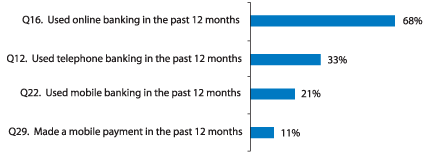Consumers and Mobile Financial Services
March 2012
- How Are Consumers Interacting with Financial Institutions?
- Current Use of Mobile Banking and Payments
- Other Mobile Financial Services
How Are Consumers Interacting with Financial Institutions?
Survey respondents were asked a set of screening questions that covered whether or not they had a bank account, access to the Internet, and ownership of mobile phones or smartphones. Survey responses indicate that the majority of American consumers use some form of technology to interact with their financial institution.
As shown in figure 1, of those consumers with regular Internet access and a bank account, 68 percent used online banking in the past 12 months. Telephone banking is the second most commonly used method of accessing financial services, with 33 percent of banked consumers reporting that they used it in the past 12 months. Mobile banking and mobile payments are the least common methods of accessing financial services, as just over a fifth of respondents with mobile phones and a bank account report using mobile banking and only 11 percent report using mobile payments in the past 12 months.

Accessible Version | Return to text
Note: The denominator varies across services due to question screening.
However, as discussed in the following section, mobile banking access appears to be gaining traction with consumers and is likely to overtake telephone banking access in the next couple of years (as measured by consumers' expectations regarding their future use of the technology).
Online Banking
Three out of ten respondents (30 percent) who use online banking are between ages 30 and 44, while 20 percent of the online banking users are age 60 and older (see tables B.88, B.91, B.94, B.97, and B.100 in Appendix 2). Online banking users are predominantly non-Hispanic whites (73 percent), while Hispanics and non-Hispanic blacks comprise about 12 percent and 8 percent of the online banking community, respectively.
Online banking users are split evenly among men and women. Use of online banking is generally unrelated to household income, with the share of online banking users by income category corresponding to their share of the population. Exceptions occurred at the tails of the income distribution, with those individuals earning less than $25,000 per year being significantly less likely to use online banking than their share of the population would suggest, while those individuals earning more than $100,000 per year being significantly more likely to use online banking than their share of the population would suggest. Level of education and use of online banking have a linear relationship, with online banking use increasing as education level increases: individuals with a bachelor's degree or higher account for 39 percent of online banking users relative to 30 percent of individuals with a bank account.
